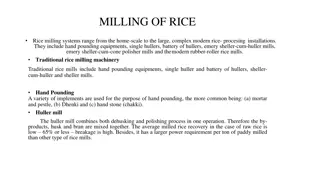Globalization and Economic Development in Southeast Asia's Rice Industry
Southeast Asia's rice industry played a crucial role in the region's globalization and economic development from the 19th to 20th centuries. Colonization, capitalism, and the rise of export industries led to significant changes in rural livelihoods, migration patterns, and trade relationships. Peasants turned rice farmers migrated to new areas, resulting in a boom in rice production and export of commodities like rubber, tea, spices, and more. The region's connection to the global economy transformed its agricultural landscape and contributed to its economic growth.
Download Presentation

Please find below an Image/Link to download the presentation.
The content on the website is provided AS IS for your information and personal use only. It may not be sold, licensed, or shared on other websites without obtaining consent from the author. Download presentation by click this link. If you encounter any issues during the download, it is possible that the publisher has removed the file from their server.
E N D
Presentation Transcript
Unit 3: Rice and Spice Lesson 7: Rice, capital, debt and rural hardship in Southeast Asia from the nineteenth to twentieth centuries
A note to users of this presentation This presentation was developed as complementary materials for teachers running this lesson. It follows the lesson plan. It includes content from the lesson plans and the introductory essays for teachers lectures. It also introduces some of the activities suggested for students. You are welcome to customize this presentation to adjust the lesson to their curriculum and to your students. You can change images, add/remove activities, and of course delete this slide, etc. The Teacher s Guide (https://sharedhistories.asia/teacher/) provides guidance on how to adjust the lessons. We wish you a successful lesson! The Southeast Asian Shared Histories project was developed by UNESCO Bangkok with funding from the Republic of Korea.
Depression Commodity Export ? ? Foreclose Landlords Migration ? Riots ?
Globalization in Southeast Asia is actually not a new phenomenon. We have learned how connected the region has been with other parts of the world through the spice trade.
in the 19th and 20th centuries, most countries in Southeast Asia were colonized. Capitalism was developing among the colonial powers. The development of the rice industry is an interesting historical case study of globalization in Southeast Asia.
The region remained well-connected to the rest of the world and witnessed tremendous economic and social development. Large numbers of peasants became rice farmers. They migrated within the country to grow rice in newly opened areas Ex: Burmese moving to the Irrawaddy River Delta, Thais and Vietnamese to the Mekong and Red River Deltas.
By 1940, Southeast Asia supplied almost of all the world s rubber, hemp, pepper, cinchona bark and teak, three-quarters of its tapioca and copra, more than half of its palm oil, more than one-third of its sisal, large amounts of sugar, tin, tea, tobacco, spices, natural resins, gums and fats, petroleum, iron, manganese and chromium. Source 1: The rise of export industries in Southeast Asia Source: Southeast Asia: From Colonialism to Independence. Owing to the existence of a strong and steadily rising demand for Burma s rice in Europe and other areas, the Irrawaddy Delta s economy expanded rapidly in the last half of the nineteenth century. Between the mid-1850s and 1900, five million additional acres of rice land were brought into production in Lower Burma, the amount of rice exported annually from Burma rose from less than two hundred thousand to over two million tons. This growth was supported by a steady rise in the price of paddy from Rs. 45 to Rs. 95 per hundred (46 lb.) baskets in Rangoon. Source 2: Development of the rice industry in Burma Source: Immigrant Asians and the Economic Impact of European Imperialism: The Role of the South Indian Chettiars in British Burma
A mixed blessing for Burma The economic growth did not benefit most Southeast Asians. uncertain nature of the export economy Southeast Asia s weak position in this economy. Growing rice for export tied farmers to an international economy based on capital: underestimated risk. Peasants borrowed money for seeds, fertilizers, basic equipment, labour,and also for personal and family expenses Borrowing from local Chinese, Indian and Burmese moneylenders land as mortgage The loans placed the peasants in debt, in a vulnerable position should demand for rice fall. https://yangontimemachine.com/2018/05/30/chettiar-hindu-temple-chettys/
Source 3: A historians observation about how the expansion of rice cultivation was a mixed blessing for Burma The country became increasingly prosperous as an addendum to the economy of the West, utilizing Western markets and enterprise, while the people remained relatively poor and quite incapable of controlling the vast economic forces playing on them. Source: A History of Modern Burma
Discussion Why was increased rice cultivation a mixed blessing for Burma? Why did many cultivators get into problems with debt? Why did some cultivators borrow from Chettiars? Why did the Chettiars share of land rise to 25 per cent by 1937? Why did bad feelings towards Chettiars and absentee landlords grow?
The Chettiars Indian moneylenders (Chettiars) were particularly hated when the price of rice plummeted during the economic depression of the 1930s The Chettiars foreclose on the land held by Burmese who could not pay their debts. The Chettiars came to own of the cultivated land in Lower Burma. The Burmese farmers now owned no land tenants who rented the land The moneylenders became absentee landlords , By 1939, 59% of the cultivated land in Lower Burma was rented out. Land alienation social problems in Burmese society Great Depression anti- Indian riots in Lower Burma. https://yangontimemachine.com/2018/05/30/chettiar-hindu-temple-chettys/
Conclusion The traditional pre-colonial economy, which used to serve the locals, became largely transformed to serve the interests of the Western industrialized nations. The Southeast Asian economy expanded into a larger, growing export-oriented economy interdependent upon economic forces elsewhere in the world, especially in the West. As a supplier of raw materials and primary products, Southeast Asia was very vulnerable to the price fluctuations of these products in the global market. Southeast Asian economies were also heavily reliant on one or a few products, so price fluctuations for these products hit the Southeast Asian countries very hard.
Role Play 1 You have the opportunity to interview a Burmese rice cultivator and a Chettiar moneylender. What questions would you like to ask them to help you learn more about the issue of land alienation in Burma?
Role play 1: Conclusion Development of the rice industry large-scale cultivation of paddy attractive to the Burmese rice cultivators But tied them to an international economy vulnerable to price fluctuations. Before 1880s, the Indian Chettiarshad financed loans to indigenous moneylenders who lent to cultivators at higher rates of interest. very few loans directly to cultivators. When the British colonial regime introduced a new system of land tenure, there was more demand for agriculture credit.
Role Play 2 The British colonial government is considering having laws in place to restrict land alienation. Four characters: two British colonial government officials, a European merchant and a Burmese landowner. Explain your views about the idea of legislation on land alienation to the other three characters in your group. Do they agree or disagree with you? Why? How is their perspective different from yours? Make a quick note of who agrees/disagrees with whom and why.
Role play 2: Conclusion In certain cases, colonial governments were unable, or unwilling to introduce measures to reduce the peasants exposure to the international economy these measures might jeopardize the rice industry. For instance, in Burma, British-owned rice mills kept rice prices low to maximize profit. Many colonial administrations in Southeast Asia were also reluctant to diversify the economy away from primary products (ex: manufacturing) competition for Western manufacturers.
Iceberg diagram analysis Based on sources and role play, do you think the Indian Chettiars were to blame for land alienation in Burma? There are numerous underlying causes that give rise to a phenomenon. What one sees above the water is only the tip of the iceberg. Often larger causes that rest beneath the surface can be difficult to detect at first.























